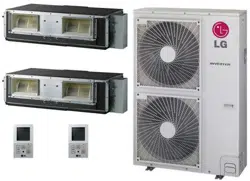Loading ...
Loading ...
Loading ...

26
MULTI F / MULTI F MAX Outdoor Unit Installation Manual
Due to our policy of continuous product innovation, some specifications may change without notification.
©LG Electronics U.S.A., Inc., Englewood Cliffs, NJ. All rights reserved. “LG” is a registered trademark of LG Corp.
MULTI
F
MAX
MULTI
F
Loosening the Flare Nuts
Always use two (2) wrenches to loosen the flare nuts.
Piping Materials and Handling
Pipes used for the refrigerant piping system must include the specified thickness, and the
interior must be clean.
Do not bend or damage the pipes while handling and storing, and take care not to con-
taminate the interior with dust, moisture, etc. See Table 11 for care of piping.
Dry Clean Airtight
Principles No moisture should be inside the piping. No dust should be inside the piping. No leaks should occur.
Problems
Caused
- Significant hydrolysis of refrigerant oil.
- Refrigerant oil degradation.
- Poor insulation of the compressor.
- System does not operate properly.
- EEVs, capillary tubes are clogged.
- Refrigerant oil degradation.
- Poor insulation of the compressor.
- System does not operate properly.
- EEVs and capillary tubes become
clogged.
- Refrigerant gas leaks / shortages.
- Refrigerant oil degradation.
- Poor insulation of the compressor.
- System does not operate properly.
Solutions
- Remove moisture from the piping.
- Piping ends should remain capped until
connections are complete.
-
Do not install piping on a rainy day.
- Connect piping properly at the unit’s side.
- Remove caps only after the piping is
cut, the burrs are removed, and after
passing the piping through the walls.
- Evacuate system to a minimum of 500
microns and insure the vacuum holds at
that level for 24 hours
- Remove dust from the piping.
- Piping ends should remain capped until
connections are complete.
- Connect piping properly at the side of
the unit.
- Remove caps only after the piping is cut
and burrs are removed.
- Retain the cap on the piping when
passing it through walls, etc.
- Test system for air tightness.
- Perform brazing procedures that comply
with all applicable standards.
- Perform flaring procedures that comply
with all applicable standards.
- Perform flanging procedures that
comply with all applicable standards.
- Ensure that refrigerant lines are pressure
tested to 550 psig.
Moisture
Dust
Leaks
Figure 19: .HHS3LSLQJ&DSSHG:KLOH6WRULQJ
Table 11: Three Principles of Refrigerant Piping
Piping Materials and Handling
GENERAL INSTALLATION GUIDELINES
Figure 20: Refrigerant Pipe Brazing.
Pressure-reducing
Valve
Valve
Taping
Nitrogen
Pipe to
be brazed
Refrigerant
Piping
Brazing Practices
All joints are brazed in the field. Multi F / Multi F MAX refrigeration system components contain very small capillary tubes, small orifices,
electronic expansion valves, oil separators, and heat exchangers that can easily become blocked. Proper system operation depends on the
installer using best practices and utmost care while assembling the piping system.
• While brazing, use a dry nitrogen purge operating at a minimum pressure of three (3) psig and maintain a steady flow.
• Blow clean all pipe sections with dry nitrogen prior to assembly.
• Use a tubing cutter. De-burr and clean all cuts before assembly.
• 6WRUHSLSHVWRFNLQDGU\SODFH.HHSSLSHFDSSHGDQGFOHDQ
• Use adapters to assemble different sizes of pipe. Use a 15% silver phosphorous copper brazing alloy to avoid overheating and produce
good flow.
• Protect isolation valves, electronic expansion valves, and other heat-sensitive control components from excessive heat with a wet rag or a
heat barrier spray product.
•
Do not use flux, soft solder, or anti-oxidant agents.
•
Do not use a saw to cut pipe.
Keep the piping system free of contaminants and debris such as copper burrs, slag, or carbon
dust during installation. Contaminants can result in mechanical failure of the system.
Loading ...
Loading ...
Loading ...
